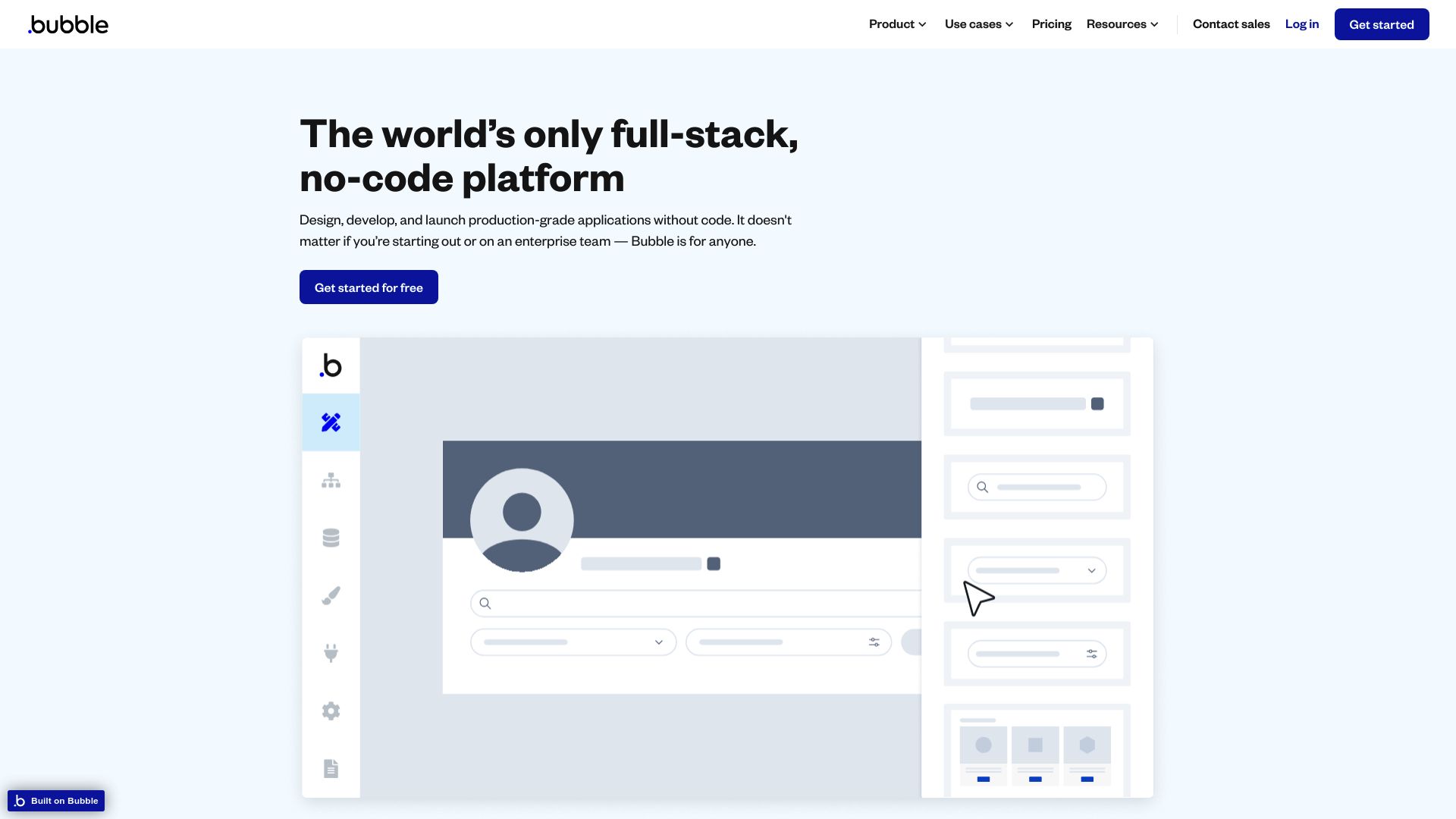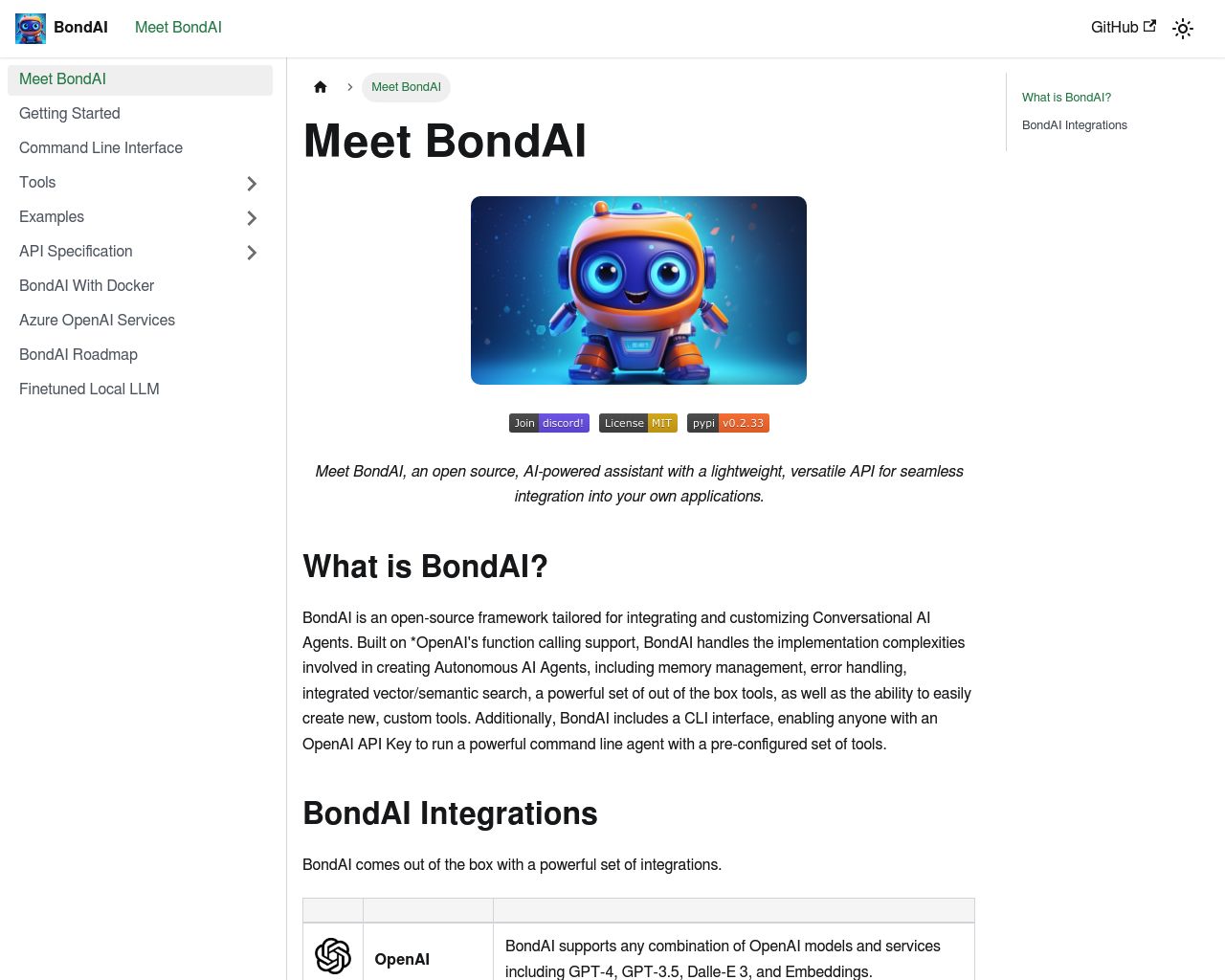Bubble vs. BondAI: Comparing AI Development Approaches
AI-powered solutions revolutionize how businesses operate, innovate, and compete. This comparison of Bubble vs. BondAI, and SmythOS illuminates the strengths and limitations of each platform in the rapidly evolving AI landscape. We explore how Bubble’s no-code approach democratizes web application development, BondAI’s framework empowers sophisticated AI agent creation, and SmythOS bridges these worlds with a unified, accessible solution for building and deploying advanced AI systems.
Whether you’re a developer seeking powerful tools, a business leader aiming to integrate AI, or an entrepreneur looking to leverage cutting-edge technology, this analysis provides crucial insights to guide your decision-making in adopting AI solutions that drive growth and efficiency.
Bubble Overview
Bubble empowers users to create web applications without coding. This visual development platform revolutionizes app creation, making it accessible to non-technical users while offering powerful tools for experienced developers.


Bubble’s drag-and-drop interface allows users to design responsive web applications visually. The platform integrates seamlessly with popular AI services, enabling the creation of intelligent applications with chatbots, content generation, and image processing capabilities. Bubble’s extensive plugin ecosystem and API connectors further expand its functionality, allowing users to incorporate advanced features without extensive programming knowledge.
Bubble’s drag-and-drop interface allows users to design responsive web applications visually. The platform integrates seamlessly with popular AI services, enabling the creation of intelligent applications…
The platform caters to a wide audience, from entrepreneurs and small businesses to large enterprises. Its scalable infrastructure, built on Amazon Web Services, ensures robust performance as applications grow. Bubble prioritizes security, offering features like data encryption and compliance certifications to meet enterprise-level requirements.
While Bubble excels in web application development, it lacks some specialized AI agent features found in dedicated AI platforms. The platform doesn’t offer built-in support for autonomous agents, multi-agent collaboration, or advanced AI explainability tools. However, Bubble’s strength lies in its ability to integrate AI capabilities into user-friendly, visually designed applications, making it an attractive option for businesses looking to leverage AI without extensive technical expertise.
BondAI Overview
BondAI empowers developers to create sophisticated AI agent systems through its open-source framework. The platform simplifies complex tasks like memory management, error handling, and semantic search, enabling the rapid development of autonomous AI agents.
BondAI empowers developers to create sophisticated AI agent systems through its open-source framework. The platform simplifies complex tasks… enabling the rapid development of autonomous AI agents.


BondAI supports advanced AI architectures, including ReAct Agents and ConversationalAgents, facilitating both individual interactions and multi-agent systems. This versatility allows for tackling complex tasks that surpass single-agent capabilities. The framework seamlessly integrates with popular services like OpenAI, Microsoft Azure, and Google Search, expanding its utility across various applications from research to customer support.
A standout feature of BondAI is its robust memory management system, inspired by the MemGPT paper. Using a tiered approach with core, conversation, and archival memory, BondAI efficiently manages extensive contexts and complex conversations. This structure enhances the problem-solving capabilities of AI agents, allowing for more nuanced and context-aware interactions.
Using a tiered approach with core, conversation, and archival memory, BondAI efficiently manages extensive contexts and complex conversations.
BondAI offers flexibility in implementation, available through a Command Line Interface, Docker containers, or direct integration into codebases. This adaptability allows users to quickly start with pre-configured tools or build custom solutions. While BondAI provides powerful capabilities for AI agent development, it requires a certain level of technical expertise to fully leverage its features, which may present a learning curve for non-technical users.
The platform’s vision centers on making advanced AI agent development more accessible and efficient. By addressing the limitations of existing tools, BondAI aims to provide a comprehensive solution for developers and researchers. Its combination of cutting-edge AI research, extensive integrations, and flexible deployment options positions BondAI as a compelling choice for those seeking to build sophisticated AI-driven applications.
Feature Comparison
Bubble and BondAI take divergent approaches to AI development and integration. Bubble excels as a no-code platform for building web applications with AI capabilities, while BondAI provides a framework for creating sophisticated AI agent systems.
Bubble’s visual builder and no-code approach make it accessible to non-technical users, allowing rapid development of web applications with integrated AI features. However, it lacks specialized AI agent capabilities like autonomous agents, multi-agent collaboration, and advanced memory management. Bubble focuses on integrating existing AI services rather than providing tools for building custom AI agents from scratch.
BondAI, in contrast, offers a robust framework for developing advanced AI agent systems. It provides sophisticated memory management, support for multi-agent collaboration, and tools for building autonomous agents. BondAI’s approach caters to developers and researchers looking to create custom AI solutions, offering flexibility in implementation through CLI, Docker containers, or direct code integration.
The platforms diverge significantly in their core components. Bubble emphasizes visual development and integration with existing services, while BondAI provides low-level tools for AI agent development. This fundamental difference impacts their security features as well. Bubble offers standard web application security measures, while BondAI focuses on AI-specific concerns like constrained alignment and advanced memory management.
We designed SmythOS to bridge this gap, offering the best of both worlds. Our platform combines the ease of use found in visual builders with the advanced AI agent capabilities of specialized frameworks. SmythOS provides a unified solution for creating, deploying, and managing sophisticated AI agents without sacrificing accessibility or power.
Feature Comparison Table
| Bubble | BondAI | SmythOS | |
|---|---|---|---|
| CORE FEATURES | |||
| Visual Builder | ✅ | ❌ | ✅ |
| No-Code Options | ✅ | ❌ | ✅ |
| Memory & Context | ❌ | ✅ | ✅ |
| Autonomous Agents | ❌ | ✅ | ✅ |
| Explainability & Transparency | ❌ | ✅ | ✅ |
| Multimodal | ❌ | ✅ | ✅ |
| Multi-Agent Collaboration | ❌ | ✅ | ✅ |
| Audit Logs for Analytics | ✅ | ❌ | ✅ |
| Bulk Work | ❌ | ✅ | ✅ |
| Agent Work Scheduler | ❌ | ✅ | ✅ |
| SECURITY | |||
| Constrained Alignment | ❌ | ❌ | ✅ |
| IP Control | ❌ | ❌ | ✅ |
| COMPONENTS | |||
| Huggingface AIs | ❌ | ✅ | ✅ |
| Classifiers | ❌ | ✅ | ✅ |
| Data Lakes | ✅ | ❌ | ✅ |
| DEPLOYMENT OPTIONS (EMBODIMENTS) | |||
| Deploy as API | ❌ | ✅ | ✅ |
| Staging Domains | ✅ | ❌ | ✅ |
| Deploy as Scheduled Agent | ❌ | ❌ | ✅ |
| DATA LAKE SUPPORT | |||
| Hosted Vector Database | ❌ | ❌ | ✅ |
| Sitemap Crawler | ❌ | ❌ | ✅ |
| YouTube Transcript Crawler | ❌ | ❌ | ✅ |
| URL Crawler | ❌ | ✅ | ✅ |
Best Alternative to Bubble and BondAI
SmythOS stands out as a superior alternative to Bubble and BondAI, combining the best aspects of both platforms while offering unique advantages. We designed SmythOS to provide a comprehensive solution for creating, deploying, and managing sophisticated AI agents without sacrificing accessibility or power.
Our platform’s intuitive drag-and-drop interface makes AI development accessible to users of all skill levels, similar to Bubble’s no-code approach. However, SmythOS goes beyond simple web applications, enabling the creation of advanced AI agents with autonomous capabilities and multi-agent collaboration. This bridges the gap between Bubble’s user-friendly design and BondAI’s powerful AI framework.
SmythOS stands out as a superior alternative to Bubble and BondAI, combining the best aspects of both platforms while offering unique advantages.
SmythOS excels in its extensive integration ecosystem, supporting a wide range of AI models, APIs, and tools. This versatility allows users to connect their AI agents to various data sources and services, surpassing both Bubble’s limited AI integrations and BondAI’s more specialized approach. Our platform’s pre-built API integrations and templates significantly reduce setup time, allowing users to focus on innovation rather than configuration.
Unlike Bubble and BondAI, SmythOS offers a complete suite of deployment options. We enable users to deploy their AI agents as APIs, chatbots, scheduled tasks, or even integrate them into existing platforms like ChatGPT. This flexibility ensures that AI solutions built with SmythOS can seamlessly fit into any workflow or business process, providing a level of versatility unmatched by either Bubble or BondAI.
Furthermore, SmythOS addresses critical enterprise needs that are often overlooked by other platforms. We provide robust security features, including constrained alignment and IP control, ensuring that AI agents operate within defined parameters and comply with organizational policies. Our platform also offers comprehensive analytics and monitoring tools, allowing users to track agent performance, optimize workflows, and maintain full visibility into their AI operations.
Conclusion
Bubble, BondAI, and SmythOS each offer unique approaches to AI development and integration. Bubble excels in no-code web application building with AI features, making it accessible to non-technical users. BondAI provides a robust framework for creating sophisticated AI agent systems, catering to developers and researchers. SmythOS, however, emerges as the superior choice by combining the strengths of both platforms and addressing their limitations.
SmythOS offers an intuitive drag-and-drop interface similar to Bubble, but with advanced AI capabilities that rival BondAI. Our platform supports multimodal interactions, autonomous agents, and multi-agent collaboration, features absent in Bubble. Unlike BondAI, which requires technical expertise, SmythOS makes these advanced AI features accessible to users of all skill levels.
We designed SmythOS to be versatile and powerful. Our platform supports a wide range of deployment options, from APIs and chatbots to scheduled agents and GPT integrations. This flexibility, combined with our extensive integration ecosystem of over 300,000 connections, positions SmythOS as the ideal solution for businesses looking to leverage AI across their operations.
To experience the full potential of AI-powered automation and innovation, explore our diverse range of AI-powered agent templates. These templates cover multiple business categories and offer a quick start to revolutionizing your workflows. Ready to take the next step? Create a free SmythOS account and start building unlimited AI agents at no cost. With our 30-day money-back guarantee, you can dive into the future of workforce automation risk-free and discover how SmythOS can transform your business processes.
Last updated:
Disclaimer: The information presented in this article is for general informational purposes only and is provided as is. While we strive to keep the content up-to-date and accurate, we make no representations or warranties of any kind, express or implied, about the completeness, accuracy, reliability, suitability, or availability of the information contained in this article.
Any reliance you place on such information is strictly at your own risk. We reserve the right to make additions, deletions, or modifications to the contents of this article at any time without prior notice.
In no event will we be liable for any loss or damage including without limitation, indirect or consequential loss or damage, or any loss or damage whatsoever arising from loss of data, profits, or any other loss not specified herein arising out of, or in connection with, the use of this article.
Despite our best efforts, this article may contain oversights, errors, or omissions. If you notice any inaccuracies or have concerns about the content, please report them through our content feedback form. Your input helps us maintain the quality and reliability of our information.
